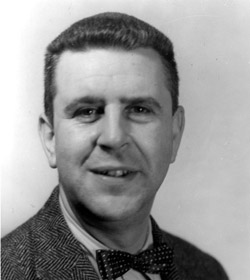Dr. Zucker-Franklin is Professor of Medicine, Langone Medical Center, New York University.
Dr. Lalezari is Professor of Medicine and Pathology, Montefiore Medical Center and Albert Einstein College of Medicine.
Dr. Marcus is Professor of Medicine, Pathology, and Laboratory Medicine, Weill Cornell Medical College and Chief of Hematology/Oncology, Manhattan VA Medical Center.
Theodore Spaet, MD, graduated from New York Medical College in 1946. After serving in the military in Japan, he trained in Boston with Dr. William Dameshek and then spent four years at Stanford University where he was closely associated with Dr. Paul Aggeler, co-discoverer of coagulation factor IX.1 This stimulated Spaet’s interest in blood coagulation. He also collaborated with Dr. Robert Evans and became interested in hemolytic anemia and thrombocytopenia.
In 1955, Spaet was recruited by Dr. Martin Cherkasky to establish a hematology division at Montefiore Hospital, in the Bronx. Montefiore Hospital was then a home for the elderly and chronically ill, but Cherkasky developed it into a world-class academic institution — an environment in which Spaet would flourish. In a tiny laboratory with a kitchen counter bench, he began training residents and postdoctoral fellows, ultimately educating more than a hundred hematologists, 60 percent of whom remained in academic medicine. He served on the NIH Hematology Study Section and was one of the original editors of the journal Thrombosis and Hemostasis. His article titled “The Platelet in Hemostasis,” published in 1964, still provides relevant insights 45 years after publication.2
Spaet’s first postdoctoral fellow, Dr. Aaron J. Marcus, was charged with the isolation and purification of phospholipids from brain and platelets and determining whether they could replace whole platelets in the thromboplastin generation test (TGT). Marcus was initially unfamiliar with laboratory procedures and methods for lipid separation. “You will do it,” Spaet simply said. This typified Spaet’s rigorous but effective philosophy of training research fellows. The efforts culminated in a paper in the Journal of Clinical Investigation3 and launched the scientific career of an ASH pioneer now in his sixth decade of productivity. Marcus, setting the precedent for future trainees, had many clinical responsibilities. On a daily basis, hematology technicians would show him blood smears they considered abnormal. These had to be reviewed and relevant patients had to be seen. He directed the performance of many further tests as appropriate, including the Rumpel-Leede test, the Duke and Ivy bleeding times and TGT, and hemoglobin electrophoresis.
Front row: T. H. Spaet in the middle with Dr. Parviz Lalezari on the right and Dr. Aaron Marcus on the left.
Front row: T. H. Spaet in the middle with Dr. Parviz Lalezari on the right and Dr. Aaron Marcus on the left.
A subsequent postdoctoral fellow, Dr. Parviz Lalezari, had a similar experience. He was told to study leukocyte antibodies. This suggestion was based on the observation by Dr. Jean Dausset that multi-transfused patients could develop leukocyte agglutinins. It was also noted that multiparous women also developed such antibodies. Lalezari was given a copy of Dausset’s textbook and told, “From now on, you are on your own.” Lalezari’s research on leukocyte antibodies led to the discovery that fetal/maternal leukocyte incompatibility could cause neonatal neutropenia.4 Subsequently, he identified neutrophilspecific antigens and described the autoimmune neutropenia of infancy. While at Stanford, Spaet suggested that Rose Payne, then a research associate, study the development of leukocyte antibodies in multiparous women. Payne’s investigation, together with the work of others, led to the description of the HLA system.
Dr. Dorothea Zucker- Franklin overcame even greater obstacles: “You’ll have to work in a cubbyhole located under the roof.” There was a very narrow staircase leading to it and no ventilation. (Little did she surmise that the heavy starch blocks used for hemoglobin electrophoresis and separation of intermediate coagulation products would have to be carried up those stairs daily!) Zucker-Franklin learned the technique of protein electrophoresis from her husband, Dr. Edward C. Franklin, a postdoctoral fellow at the Rockefeller Institute. Eventually, this led to isolation and purification of Product I, anintermediate in the coagulation cascade.5
In the 1960s, Spaet and Lalezari, then Blood Bank director at Montefiore, announced that blood for transfusion would be available only for life-threatening blood loss, treatment of aplastic anemia, or surgical procedures, but not for wound healing or other ill-defined conditions. Spaet’s irresistible power of persuasion was the major factor in the success of this paradigm-shifting program.
Many additional examples could be cited to convey the essence of Spaet’s impact on academic hematology. He died at a relatively young age, but left a legacy of a remarkable number of productive academic hematologists who were spawned directly from his laboratory or from those of his trainees. Importantly, all his trainees were taught to be productive at the bench and caring physicians at the bedside.


